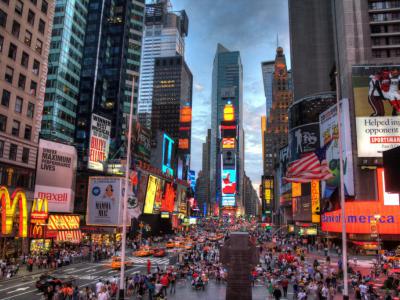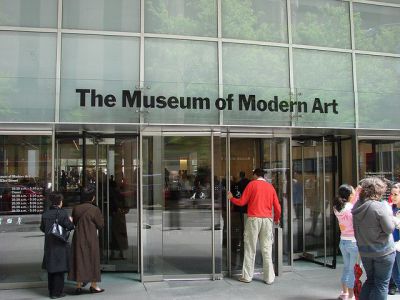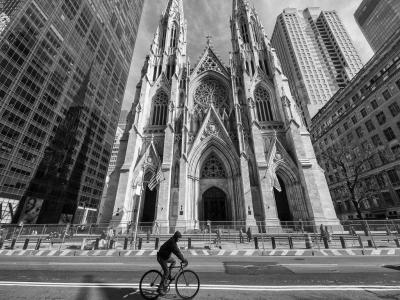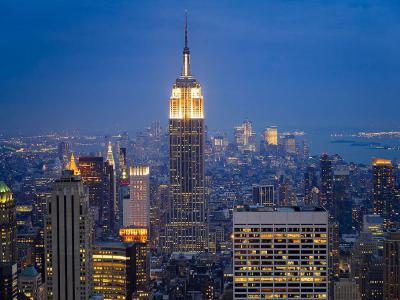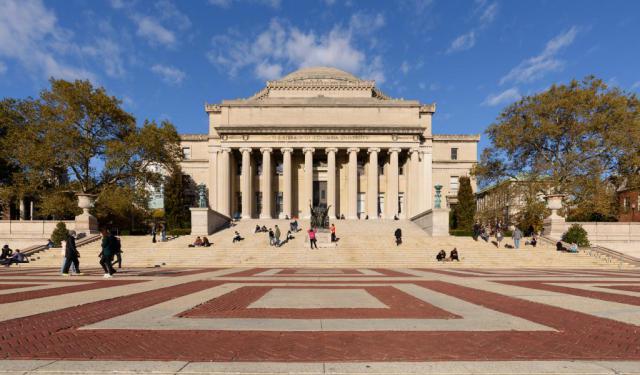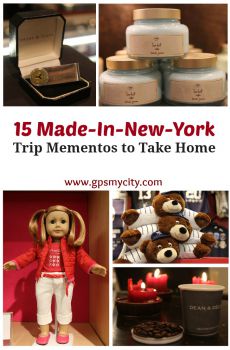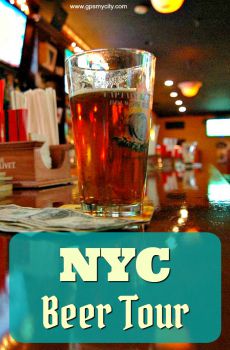
Midtown Manhattan Walking Tour (Self Guided), New York
Welcome to the iconic New York City that so many tourists dream about before they visit – spectacular skyscrapers, iconic public buildings, large neon flat screens above ground level and the non-stop activity on city streets.
They say if you can make it there, you can make it anywhere, and Times Square, Broadway, is definitely a part of that slogan. Day time or night time, it’s one of the biggest tourist attractions in the world. A spectacular place where you’ll be surrounded by clothing stores, billboard signs, TV studios, and some of the best pizza places in town.
At the heart of Midtown, visit the Rockefeller Center to experience towering Art Deco grandeur at its finest. There’s always much to see and do there; you may just have time to stroll around, explore the storefront windows and themed artwork, or check out the “Top of the Rock” attraction to see and take pictures of NYC’s majestic skyline.
Walking around Midtown means passing by other unique buildings like St Patrick’s Cathedral, known as the largest Gothic temple in the country. You can discover shops, restaurants, and iconic paintings at the Grand Central Terminal, or admire the New York Public Library and Bryant Park at 42nd Street.
The arts are well served as well: the Museum of Modern Art is the most extensive of its kind in the world, and the shows on Broadway boast some of the best productions, from blockbuster musicals to intense and intimate dramas.
On the last stretch, don’t miss a trip to the Empire State Building and Macy’s huge flagship store in Herald Square. More recently, the store made headlines with plans to build an office tower of up to 290 meters (950 feet) high on the same building, as well as to pedestrianize the entire area.
For an excellent day out in Midtown Manhattan, follow this self-guided walking tour!
They say if you can make it there, you can make it anywhere, and Times Square, Broadway, is definitely a part of that slogan. Day time or night time, it’s one of the biggest tourist attractions in the world. A spectacular place where you’ll be surrounded by clothing stores, billboard signs, TV studios, and some of the best pizza places in town.
At the heart of Midtown, visit the Rockefeller Center to experience towering Art Deco grandeur at its finest. There’s always much to see and do there; you may just have time to stroll around, explore the storefront windows and themed artwork, or check out the “Top of the Rock” attraction to see and take pictures of NYC’s majestic skyline.
Walking around Midtown means passing by other unique buildings like St Patrick’s Cathedral, known as the largest Gothic temple in the country. You can discover shops, restaurants, and iconic paintings at the Grand Central Terminal, or admire the New York Public Library and Bryant Park at 42nd Street.
The arts are well served as well: the Museum of Modern Art is the most extensive of its kind in the world, and the shows on Broadway boast some of the best productions, from blockbuster musicals to intense and intimate dramas.
On the last stretch, don’t miss a trip to the Empire State Building and Macy’s huge flagship store in Herald Square. More recently, the store made headlines with plans to build an office tower of up to 290 meters (950 feet) high on the same building, as well as to pedestrianize the entire area.
For an excellent day out in Midtown Manhattan, follow this self-guided walking tour!
How it works: Download the app "GPSmyCity: Walks in 1K+ Cities" from Apple App Store or Google Play Store to your mobile phone or tablet. The app turns your mobile device into a personal tour guide and its built-in GPS navigation functions guide you from one tour stop to next. The app works offline, so no data plan is needed when traveling abroad.
Midtown Manhattan Walking Tour Map
Guide Name: Midtown Manhattan Walking Tour
Guide Location: USA » New York (See other walking tours in New York)
Guide Type: Self-guided Walking Tour (Sightseeing)
# of Attractions: 10
Tour Duration: 2 Hour(s)
Travel Distance: 4.1 Km or 2.5 Miles
Author: doris
Sight(s) Featured in This Guide:
Guide Location: USA » New York (See other walking tours in New York)
Guide Type: Self-guided Walking Tour (Sightseeing)
# of Attractions: 10
Tour Duration: 2 Hour(s)
Travel Distance: 4.1 Km or 2.5 Miles
Author: doris
Sight(s) Featured in This Guide:
- Times Square
- Broadway
- Museum of Modern Art (MoMA)
- St. Patrick's Cathedral
- Rockefeller Center
- Grand Central Terminal
- New York Public Library
- Bryant Park
- Empire State Building
- Macy's in Herald Square
1) Times Square (must see)
Once a native pathway running the length of the Island of Manhattan, Broadway, unlike other streets in NYC, was not laid out on a grid. Hence, it intersects with Seventh Avenue and 42nd Street, forming two triangular shapes, like a bow tie. Times Square is the name of the southern triangle, while the northern triangle is called Duffy Square, after Father Francis P. Duffy of the 69th Infantry Regiment of World War I.
The section of Broadway between 41st and 53rd Streets, clustered around Times Square, is also often referred to as the Great White Way. The nickname comes from the many lit-up billboards, posters, and marquees that promote plays and musicals in Theater District. This frenetic pedestrian area is the heart of the city's entertainment industry, and it draws annually up to 50 million visitors (or 330,000 souls per day), who come here by subway or simply walking, while looking for something extraordinary.
Times Square was known as Longacre Square until 1904, when Adolph S. Ochs, the owner and publisher of The New York Times, moved his headquarters into the newly erected Times Building, currently One Times Square. Within a decade, the New York Times outgrew its space and moved offices again, but not before starting a tradition of the annual New Year's Eve Ball Drop. The tradition began on December 31, 1907, and continues to date, attracting over a million visitors every year.
The square has many other attractions like ABC's Times Square Studios, The Bubba Gump Shrimp Company (Seafood), and Planet Hollywood, to mention but a few. The illuminated signs in Times Square rival those of Las Vegas, and, according to their size, are called either "spectaculars" or "jumbotrons."
Among these are quite a few neon-lit signboards of retail establishments like Gap, Old Navy, Forever 21, Levi’s, Disney Store, the Hershey’s and M&M, that make up the Times Square shopping scene. This commercial hub in the center of Midtown Manhattan is also ideal for scooping up a souvenir to commemorate your stay in NYC.
The section of Broadway between 41st and 53rd Streets, clustered around Times Square, is also often referred to as the Great White Way. The nickname comes from the many lit-up billboards, posters, and marquees that promote plays and musicals in Theater District. This frenetic pedestrian area is the heart of the city's entertainment industry, and it draws annually up to 50 million visitors (or 330,000 souls per day), who come here by subway or simply walking, while looking for something extraordinary.
Times Square was known as Longacre Square until 1904, when Adolph S. Ochs, the owner and publisher of The New York Times, moved his headquarters into the newly erected Times Building, currently One Times Square. Within a decade, the New York Times outgrew its space and moved offices again, but not before starting a tradition of the annual New Year's Eve Ball Drop. The tradition began on December 31, 1907, and continues to date, attracting over a million visitors every year.
The square has many other attractions like ABC's Times Square Studios, The Bubba Gump Shrimp Company (Seafood), and Planet Hollywood, to mention but a few. The illuminated signs in Times Square rival those of Las Vegas, and, according to their size, are called either "spectaculars" or "jumbotrons."
Among these are quite a few neon-lit signboards of retail establishments like Gap, Old Navy, Forever 21, Levi’s, Disney Store, the Hershey’s and M&M, that make up the Times Square shopping scene. This commercial hub in the center of Midtown Manhattan is also ideal for scooping up a souvenir to commemorate your stay in NYC.
2) Broadway (must see)
Broadway, known as the Wickquasgeck Trail in the New Amsterdam time, was snaked along the length of Manhattan Island. The trail became the main road through the island. Actual Broadway is a bit longer than the old trail it replaced. The street starts at Bowling Green in the southern tip of Manhattan and wends its way through the Bronx, and through Westchester County, all the way up to Sleepy Hollow. It is the oldest thoroughfare in the city.
When the Dutch took over Manhattan, they widened the trail to road size. They called it "Gentlemen's Way" or "Heeren Weigh" in Dutch. When the British arrived, they noticed how wide the main street was, and called it Broadway Street.
By 1907 a 30-block section of Broadway between Times Square and Sherman Square at 72nd Street was a part of Manhattan, referred to as "Automobile Row." The motorcar had arrived. Automobile dealerships, showrooms, parts stores, and garages, packed both sides of the street. In time Broadway became mostly a one-way traffic lane in Manhattan.
In the current century, Broadway has been made less accommodating to cars and more pedestrian friendly. Traffic lanes at strategic places have been turned into public plazas and mini-parks. Bicycle lanes have been established between 42nd Street and Union Square.
Since 2009, parts of Broadway in Times Square, Duffy Square, and Herald Square have been closed to automotive traffic. Broadway has been narrowed around Madison Square and Union Square, permitting pedestrian plazas to exist at the roadside.
Lower Broadway at Bowling Green and City Hall Park is the customary venue for the city's famous "ticker tape" parades, when large amounts of shredded paper are thrown from nearby office buildings into the parade route, creating a celebratory effect. It has been referred to as the "Canyon of Heroes." Paper showers still are dropped from skyscrapers lining the route, but ticker tape is long a thing of the past. Toilet rolls have been used, but the effect is not so grand.
"The Great White Way" is about the section of Broadway in Midtown Manhattan, home to the Theatre District. The district stretches between 42nd Street and 53rd Street, including Times Square. Shep Friedman, a reporter for the New York Morning Telegraph in 1901, was the first to use the phrase "Great White Way" about Broadway.
Everything and anything happens on Broadway. From Bowling Green to Sleepy Hollow, the stories, the neighborhoods, and the hits just keep on coming.
When the Dutch took over Manhattan, they widened the trail to road size. They called it "Gentlemen's Way" or "Heeren Weigh" in Dutch. When the British arrived, they noticed how wide the main street was, and called it Broadway Street.
By 1907 a 30-block section of Broadway between Times Square and Sherman Square at 72nd Street was a part of Manhattan, referred to as "Automobile Row." The motorcar had arrived. Automobile dealerships, showrooms, parts stores, and garages, packed both sides of the street. In time Broadway became mostly a one-way traffic lane in Manhattan.
In the current century, Broadway has been made less accommodating to cars and more pedestrian friendly. Traffic lanes at strategic places have been turned into public plazas and mini-parks. Bicycle lanes have been established between 42nd Street and Union Square.
Since 2009, parts of Broadway in Times Square, Duffy Square, and Herald Square have been closed to automotive traffic. Broadway has been narrowed around Madison Square and Union Square, permitting pedestrian plazas to exist at the roadside.
Lower Broadway at Bowling Green and City Hall Park is the customary venue for the city's famous "ticker tape" parades, when large amounts of shredded paper are thrown from nearby office buildings into the parade route, creating a celebratory effect. It has been referred to as the "Canyon of Heroes." Paper showers still are dropped from skyscrapers lining the route, but ticker tape is long a thing of the past. Toilet rolls have been used, but the effect is not so grand.
"The Great White Way" is about the section of Broadway in Midtown Manhattan, home to the Theatre District. The district stretches between 42nd Street and 53rd Street, including Times Square. Shep Friedman, a reporter for the New York Morning Telegraph in 1901, was the first to use the phrase "Great White Way" about Broadway.
Everything and anything happens on Broadway. From Bowling Green to Sleepy Hollow, the stories, the neighborhoods, and the hits just keep on coming.
3) Museum of Modern Art (MoMA)
Undaunted by the Wall Street Crash of 1929, the socialite and philanthropist Abby Rockefeller and two of her friends, art collectors Lillie Bliss, and Mary Quinn Sullivan opened their new museum at the Heckscher Building at 750 Fifth Avenue in Manhattan. It opened to the public on November 7, 1929. The venture was the primary museum in America dedicated solely to Modern Art and European Modernism. In the next ten years, the MoMA relocated three times.
Since 1939 the museum has made its home on 53rd Street in Manhattan, between Fifth and Sixth Avenues. The museum has played a vital role in collecting and promoting Modern Art. It is reputed to be one of the most important museums of modern art in the world.
The collection holds contemporary art, such as works of architecture, design, painting, sculpture, prints, art journals, photos, films, and electronic media. MoMA has a library with more than 300,000 books and catalogs of exhibitions. There are over 1,000 periodicals and 40,000 items of ephemera relating to artists and their associations.
The museum is made up of six Custodial Departments: Architecture and Design, Drawings and Prints, Film, Media and Performance, Painting and Sculpture, and Photography. Museum holdings involve more than 150,000 separate pieces plus 22,000 films, and over 13,000 artists are represented.
Painting Collection highlights include works by Rodin, Matisse, Picasso, Braque, Miro, Mondrian, Duchamp, Klee, Magritte, O'Keeffe, Hopper, Gorky, Giacometti, de Kooning, Pollock, Rothko, Rauschenberg, Stella, Warhol, and Lichtenstein, to mention a few.
MoMA is housed in a sleek modernist building on 53rd Street. Straight ahead, through the expansive lobby is the open Sculpture Garden with trees, sculptures, and reflecting pools. Staircases and elevators lead to the exhibition halls above. There are several cafeterias. A motion picture theatre has showings on most days.
The museum is open every day. There is an admission charge but admission is free on Fridays after 5:30 pm.
Since 1939 the museum has made its home on 53rd Street in Manhattan, between Fifth and Sixth Avenues. The museum has played a vital role in collecting and promoting Modern Art. It is reputed to be one of the most important museums of modern art in the world.
The collection holds contemporary art, such as works of architecture, design, painting, sculpture, prints, art journals, photos, films, and electronic media. MoMA has a library with more than 300,000 books and catalogs of exhibitions. There are over 1,000 periodicals and 40,000 items of ephemera relating to artists and their associations.
The museum is made up of six Custodial Departments: Architecture and Design, Drawings and Prints, Film, Media and Performance, Painting and Sculpture, and Photography. Museum holdings involve more than 150,000 separate pieces plus 22,000 films, and over 13,000 artists are represented.
Painting Collection highlights include works by Rodin, Matisse, Picasso, Braque, Miro, Mondrian, Duchamp, Klee, Magritte, O'Keeffe, Hopper, Gorky, Giacometti, de Kooning, Pollock, Rothko, Rauschenberg, Stella, Warhol, and Lichtenstein, to mention a few.
MoMA is housed in a sleek modernist building on 53rd Street. Straight ahead, through the expansive lobby is the open Sculpture Garden with trees, sculptures, and reflecting pools. Staircases and elevators lead to the exhibition halls above. There are several cafeterias. A motion picture theatre has showings on most days.
The museum is open every day. There is an admission charge but admission is free on Fridays after 5:30 pm.
4) St. Patrick's Cathedral (must see)
There are two St. Patrick's Cathedrals in New York City. The construction of New St. Patrick's Cathedral was started in 1858 to accommodate the growing Archdiocese of New York and to replace St. Patrick's Old Cathedral, built in 1815. New St. Patrick's is the enormous Gothic Revival edifice erected between 50th and 51st Streets on Madison Avenue in Manhattan. It is the seat of the Archbishop of New York. Located directly across from Rockefeller Center, it was designed by architect James Renwick, Jr., and inaugurated in 1879.
The Midtown Cathedral is triumphantly vertical and Gothic. It is clad in marble. It has dozens of stained glass windows encased in pointed arches topped by triangular pediments. It is 332 feet long and the transepts are 174 feet wide. Soaring spires flank the enormous bronze entrance doors. The spires reach a height of 330 feet.
Inside is a nave with a center aisle and two side aisles. Thirty-two marble columns separate the center and side aisles. Above the center aisle are groin vaults supported by ribs and bosses. There are 12 chapels in the side aisles. The interior is designed for a seating capacity of 2,400. There are 300 wooden pews.
The high altar is a replacement. The original was moved to Fordham University Church in the Bronx. The current altar is made of grey-white Italian marble covered with a bronze canopy or baldachin. There is no tabernacle or altar screen. The baldachin is topped by a statue of Christ the King flanked by angels and pinnacles.
The New St. Patrick's Cathedral is a New York City designated landmark and is listed on the National Register of Historic Places.
The Midtown Cathedral is triumphantly vertical and Gothic. It is clad in marble. It has dozens of stained glass windows encased in pointed arches topped by triangular pediments. It is 332 feet long and the transepts are 174 feet wide. Soaring spires flank the enormous bronze entrance doors. The spires reach a height of 330 feet.
Inside is a nave with a center aisle and two side aisles. Thirty-two marble columns separate the center and side aisles. Above the center aisle are groin vaults supported by ribs and bosses. There are 12 chapels in the side aisles. The interior is designed for a seating capacity of 2,400. There are 300 wooden pews.
The high altar is a replacement. The original was moved to Fordham University Church in the Bronx. The current altar is made of grey-white Italian marble covered with a bronze canopy or baldachin. There is no tabernacle or altar screen. The baldachin is topped by a statue of Christ the King flanked by angels and pinnacles.
The New St. Patrick's Cathedral is a New York City designated landmark and is listed on the National Register of Historic Places.
5) Rockefeller Center (must see)
In 1801, New York physician David Hosack bought 22 acres of open land from the city with an aim to establish the country's first botanical garden, the Elgin Botanic Garden. The latter had lasted only until 1811, for the lack of funds, following which the territory was taken over by Columbia University, in 1823.
In 1926, the property changed hands again when the Metropolitan Opera sought location for its new home; so the University leased the land to the theater's benefactor, John D. Rockefeller, Jr. After the stock market crashed, in 1929, the Met Opera move was canceled, and Rockefeller decided to build a mass media complex instead.
The ensued talks between Radio Corporation of America, National Broadcasting Company, and Radio-Keith-Orpheum Radio resulted in an agreement, in 1930, to build on the site an entertainment complex. Pursuant to this agreement, 228 buildings were demolished and 4,000 tenants relocated. Early on, the project was called "Radio City," "Rockefeller City," or "Metropolitan Square."
Presently, Rockefeller Center represents a compound of two complexes (comprising 14 Art Deco-style buildings), one solitary edifice on 51st Street (added in 1947), and four towers on the west side of Sixth Avenue. The venue covers all of Doctor Hosack's 22 acres, and, whilst there's no botanicals on the ground, it does have some rooftop gardens.
Radio City Music Hall occupies the western part of the Center. The Lower Plaza, at the heart of the complex, lends a sense of privacy, being sunken below street level. Architect Ieoh Ming Pei praised it as "the most successful open space in the United States, perhaps in the world." Most of the Plaza's outdoor area is taken up by an ice rink, installed in 1936.
In addition to the spectacular, unobstructed views of the NYC skyline opening from the top of the Rock’s three levels of indoor and outdoor observation decks, the Center offers a shopping experience like no other. The abundant choice of popular local brands, international names, and up-and-coming designers makes it one of the best shopping destinations in Midtown Manhattan. This is where you come to realize that shopping is as much about the place as it is about what you buy.
In 1926, the property changed hands again when the Metropolitan Opera sought location for its new home; so the University leased the land to the theater's benefactor, John D. Rockefeller, Jr. After the stock market crashed, in 1929, the Met Opera move was canceled, and Rockefeller decided to build a mass media complex instead.
The ensued talks between Radio Corporation of America, National Broadcasting Company, and Radio-Keith-Orpheum Radio resulted in an agreement, in 1930, to build on the site an entertainment complex. Pursuant to this agreement, 228 buildings were demolished and 4,000 tenants relocated. Early on, the project was called "Radio City," "Rockefeller City," or "Metropolitan Square."
Presently, Rockefeller Center represents a compound of two complexes (comprising 14 Art Deco-style buildings), one solitary edifice on 51st Street (added in 1947), and four towers on the west side of Sixth Avenue. The venue covers all of Doctor Hosack's 22 acres, and, whilst there's no botanicals on the ground, it does have some rooftop gardens.
Radio City Music Hall occupies the western part of the Center. The Lower Plaza, at the heart of the complex, lends a sense of privacy, being sunken below street level. Architect Ieoh Ming Pei praised it as "the most successful open space in the United States, perhaps in the world." Most of the Plaza's outdoor area is taken up by an ice rink, installed in 1936.
In addition to the spectacular, unobstructed views of the NYC skyline opening from the top of the Rock’s three levels of indoor and outdoor observation decks, the Center offers a shopping experience like no other. The abundant choice of popular local brands, international names, and up-and-coming designers makes it one of the best shopping destinations in Midtown Manhattan. This is where you come to realize that shopping is as much about the place as it is about what you buy.
6) Grand Central Terminal (must see)
The terms Grand Central Terminal and Grand Central Station are used interchangeably, but the station is also the central post office joined at the hip to the rail terminal. The business magnate Cornelius Vanderbilt bought the Hudson River and New York Central railroads in 1867. He merged them and started work on Grand Central Depot in 1869.
Architect John B. Snook designed the Grand Central Depot in the Second Empire style. The depot, with all its improvements, was completed by 1874. Trains approaching from the north would descend into the Park Avenue Tunnel at 96th street and travel underground to the terminal. This was a much safer deal than rattling down the crowded streets.
In 1902, a southbound steam locomotive ran past signals in the smoke-filled Park Avenue Tunnel and crashed into another train. After this accident, the depot was torn down and replaced by the current Grand Central Terminal. The architectural firm of Reed and Stern was responsible for the overall design of the station, while Warren and Wetmore worked on the Beaux-Arts exterior.
Grand Central Terminal features permanent works of art, including the celestial ceiling in the Main Concourse, the Glory of Commerce work, the statue of Cornelius Vanderbilt in front of the building's south facade, and the two cast-iron eagle statues adorning the terminal's facades.
Exhibitions and events are held regularly in Vanderbilt Hall. The Dining Concourse has exhibits of lightboxes. The terminal is also known for its performance and installation art, including flash mobs and other spontaneous events.
Architect John B. Snook designed the Grand Central Depot in the Second Empire style. The depot, with all its improvements, was completed by 1874. Trains approaching from the north would descend into the Park Avenue Tunnel at 96th street and travel underground to the terminal. This was a much safer deal than rattling down the crowded streets.
In 1902, a southbound steam locomotive ran past signals in the smoke-filled Park Avenue Tunnel and crashed into another train. After this accident, the depot was torn down and replaced by the current Grand Central Terminal. The architectural firm of Reed and Stern was responsible for the overall design of the station, while Warren and Wetmore worked on the Beaux-Arts exterior.
Grand Central Terminal features permanent works of art, including the celestial ceiling in the Main Concourse, the Glory of Commerce work, the statue of Cornelius Vanderbilt in front of the building's south facade, and the two cast-iron eagle statues adorning the terminal's facades.
Exhibitions and events are held regularly in Vanderbilt Hall. The Dining Concourse has exhibits of lightboxes. The terminal is also known for its performance and installation art, including flash mobs and other spontaneous events.
7) New York Public Library (must see)
Also known as the Stephan A. Schwartzman Building, the Main Branch of 42nd Street Library is an embodiment of the New York Public Library system. It is located on Fifth Avenue between 40th and 42nd Streets. It shares the block with Bryant Park. The structure is a Beaux-Arts gem of a building.
The Astor and Lenox Libraries were merged in 1895. An imposing main branch was needed to house the newly formed New York Public Library. The perfect site for the new building was under the old obsolete Croton Distributing Reservoir. The architectural firm of Carrere and Hastings was selected to design and build the new library.
On May 24, 1911, the library opened to the public. The first volume borrowed from the library's collection was "Ethical Ideas of Our Time: a study of Nietzsche and Lev Tolstoy" by Russian philosopher and writer Nikolai Grot. During the first week of its operation, the library received 250,000 visitors and patrons.
The exterior of the library building is of Vermont marble and brick. Windows, doors, and fixtures are bronze. Pediments installed above the central entrance hold sculptures of "Life," "Painting," and "Sculpture." A balcony wraps the Fifth Avenue elevation.
At the main entrance, a grand staircase leads to a portico with six Corinthian columns and three archways. Two lions of Tennessee marble guard the staircase on either side.
The Astor and Lenox Libraries were merged in 1895. An imposing main branch was needed to house the newly formed New York Public Library. The perfect site for the new building was under the old obsolete Croton Distributing Reservoir. The architectural firm of Carrere and Hastings was selected to design and build the new library.
On May 24, 1911, the library opened to the public. The first volume borrowed from the library's collection was "Ethical Ideas of Our Time: a study of Nietzsche and Lev Tolstoy" by Russian philosopher and writer Nikolai Grot. During the first week of its operation, the library received 250,000 visitors and patrons.
The exterior of the library building is of Vermont marble and brick. Windows, doors, and fixtures are bronze. Pediments installed above the central entrance hold sculptures of "Life," "Painting," and "Sculpture." A balcony wraps the Fifth Avenue elevation.
At the main entrance, a grand staircase leads to a portico with six Corinthian columns and three archways. Two lions of Tennessee marble guard the staircase on either side.
8) Bryant Park
Bryant Park is an 8-acre public park right in front of the New York Public Library. The oasis of greenery in the very heart of New York City sets amid the spectacular towering skyscrapers, such as the W.R.Grace building, the Bank of America, and the Bryant Park Hotel. This is the place where New Yorkers and visitors love to come for lunch or just to stretch out and take it easy for a while.
In 1686, when the area was still a wilderness, New York's colonial governor, Thomas Dongan, designated the area now known as Bryant Park as a public space. George Washington's troops crossed the area while retreating from the Battle of Long Island in 1776.
The first park on this site was called Reservoir Square, named after the adjacent Croton distributing reservoir. The square was the scene of the New York Draft Riots of July 1863 during the American Civil War. In 1884, it was renamed Bryant Park, after New York Evening Post editor and abolitionist William Cullen Bryant, whose statue now holds a prominent place in the park. In the 1970s the park had entered a state of deterioration, due to a lack of maintenance.
In 1988, the privately funded Bryant Park Restoration Corporation took over the matter, and the park was made into a safe and beautiful recreational area with movable chairs, chess tables, and cafes. The park is a regular host of fashion shows and summer film festivals and has a popular ice skating rink in winter.
In 1686, when the area was still a wilderness, New York's colonial governor, Thomas Dongan, designated the area now known as Bryant Park as a public space. George Washington's troops crossed the area while retreating from the Battle of Long Island in 1776.
The first park on this site was called Reservoir Square, named after the adjacent Croton distributing reservoir. The square was the scene of the New York Draft Riots of July 1863 during the American Civil War. In 1884, it was renamed Bryant Park, after New York Evening Post editor and abolitionist William Cullen Bryant, whose statue now holds a prominent place in the park. In the 1970s the park had entered a state of deterioration, due to a lack of maintenance.
In 1988, the privately funded Bryant Park Restoration Corporation took over the matter, and the park was made into a safe and beautiful recreational area with movable chairs, chess tables, and cafes. The park is a regular host of fashion shows and summer film festivals and has a popular ice skating rink in winter.
9) Empire State Building (must see)
The king of Art Deco skyscrapers, the 102-story Empire State Building soars to 1,454 feet above the sidewalks of Manhattan. Once the tallest building in the world, it is now the seventh-tallest in New York, ninth in the USA, and 54th in the world. It is still the sixth-tallest freestanding edifice in the Americas.
The name "Empire State" is the nickname of the State of New York. The design of the building was created by the architectural firm Shrive, Lamb & Harmon. Construction started in 1930 and finished in 1931. The skyscraper stands on the site of the old Waldorf-Astoria Hotel, built in 1893. The builders of the Empire State determined it should be the highest in the world.
The Empire State sits in Midtown South on the west side of Fifth Avenue between 34th and 35th Streets. The 80th, 86th, and 102nd floors have observatories with a commanding 360-degree view of just about everything. The Empire State Building is a cultural icon. It has been featured in more than 250 television series and films since the film King Kong was broadcast in 1933.
The facade is made of Indiana limestone and granite. The decorations on the exterior are mainly geometric, without narrative. The metal doors of the main entrance are flanked by molded piers topped with streamlined eagles and a transom with the golden letters of its name.
The Empire State Building was designated a city landmark by the New York City landmarks Preservation Commission in 1980 and was added to the list of National Historic Landmarks in 1986.
The name "Empire State" is the nickname of the State of New York. The design of the building was created by the architectural firm Shrive, Lamb & Harmon. Construction started in 1930 and finished in 1931. The skyscraper stands on the site of the old Waldorf-Astoria Hotel, built in 1893. The builders of the Empire State determined it should be the highest in the world.
The Empire State sits in Midtown South on the west side of Fifth Avenue between 34th and 35th Streets. The 80th, 86th, and 102nd floors have observatories with a commanding 360-degree view of just about everything. The Empire State Building is a cultural icon. It has been featured in more than 250 television series and films since the film King Kong was broadcast in 1933.
The facade is made of Indiana limestone and granite. The decorations on the exterior are mainly geometric, without narrative. The metal doors of the main entrance are flanked by molded piers topped with streamlined eagles and a transom with the golden letters of its name.
The Empire State Building was designated a city landmark by the New York City landmarks Preservation Commission in 1980 and was added to the list of National Historic Landmarks in 1986.
10) Macy's in Herald Square
Since its opening in 1902, the legendary Macy's flagship store in Herald Square has been a shopping paradise for visitors and an architectural icon and landmark of New York City. A store like no other, it has continued to be a trendsetter from its inception and was the first building to have a modern-day escalator. With 1,250,000 square feet of retail space under one roof, Macy's is one of the largest department stores in the United States. It was added to the list of National Historic Landmarks in 1978.
The store covers an entire city block with 11 levels of the latest fashions, featuring a dazzling array of designer brands, choices, and quality which never fail to amaze. Restaurants and cafes can be found throughout the store, and exciting events are held here almost every day.
The place is also famous for its elaborate animated holiday and Christmas window displays. Each year presents a different theme shown in six windows on the Broadway side of the building.
Macy's is known for its great sales, especially compared to other major New York City department stores. If you crave some refreshment or feel like having a bite, there are plenty of dining options to consider, from casual, fast-food eateries to the more refined sit-down restaurants, so there's no reason for you to go hungry or thirsty while shopping at Macy's.
The store covers an entire city block with 11 levels of the latest fashions, featuring a dazzling array of designer brands, choices, and quality which never fail to amaze. Restaurants and cafes can be found throughout the store, and exciting events are held here almost every day.
The place is also famous for its elaborate animated holiday and Christmas window displays. Each year presents a different theme shown in six windows on the Broadway side of the building.
Macy's is known for its great sales, especially compared to other major New York City department stores. If you crave some refreshment or feel like having a bite, there are plenty of dining options to consider, from casual, fast-food eateries to the more refined sit-down restaurants, so there's no reason for you to go hungry or thirsty while shopping at Macy's.
Walking Tours in New York, New York
Create Your Own Walk in New York
Creating your own self-guided walk in New York is easy and fun. Choose the city attractions that you want to see and a walk route map will be created just for you. You can even set your hotel as the start point of the walk.
Manhattan Architecture Walking Tour
The skyscraper, which has shaped Manhattan's distinctive skyline, has been closely associated with New York City’s identity since the end of the 19th century. Despite the Great Depression, some of the world’s tallest skyscrapers were completed in Manhattan during the 1930s, including numerous Art Deco masterpieces that are still part of the city's skyline – most notably the Empire... view more
Tour Duration: 2 Hour(s)
Travel Distance: 4.2 Km or 2.6 Miles
Tour Duration: 2 Hour(s)
Travel Distance: 4.2 Km or 2.6 Miles
Times Square to Central Park
A leisurely self-guided stroll from Times Square to Central Park will take you to some of NYC’s prominent locations, each worth visiting in their own right.
At 49th Street, Fifth Avenue lives up to its lofty reputation with the Rockefeller Center, one of the world’s biggest business and entertainment complexes, and a triumph of Art Deco architecture. Like the neighboring Times Square, the... view more
Tour Duration: 2 Hour(s)
Travel Distance: 3.2 Km or 2 Miles
At 49th Street, Fifth Avenue lives up to its lofty reputation with the Rockefeller Center, one of the world’s biggest business and entertainment complexes, and a triumph of Art Deco architecture. Like the neighboring Times Square, the... view more
Tour Duration: 2 Hour(s)
Travel Distance: 3.2 Km or 2 Miles
Best of Lower Manhattan Walking Tour
Every part of Manhattan is terrific, but if you are looking for one that showcases the best overview of New York City’s history and architectural styles, it’s Lower Manhattan. This is where it all started, where New Amsterdam was founded, where Canal Street used to be a canal, and where Wall Street used to be a wall marking the end of town. It’s also where the city has seen the most tragedy,... view more
Tour Duration: 2 Hour(s)
Travel Distance: 3.1 Km or 1.9 Miles
Tour Duration: 2 Hour(s)
Travel Distance: 3.1 Km or 1.9 Miles
Columbia University Walking Tour
Established in 1754, Columbia University is the oldest institution of higher education in the state of New York and the fifth-oldest in the United States. A member of the prestigious Ivy League, this renowned institution boasts a diverse campus designed along Beaux-Arts planning principles. Columbia's main campus occupies more than six city blocks in Morningside Heights, New York City, and is... view more
Tour Duration: 2 Hour(s)
Travel Distance: 2.3 Km or 1.4 Miles
Tour Duration: 2 Hour(s)
Travel Distance: 2.3 Km or 1.4 Miles
Brooklyn New York Walking Tour
Named after the Breukelen village in the Netherlands, Brooklyn, one of New York City’s five boroughs, occupies the western tip of Long Island. Its history began in the 17th century as a small Dutch settlement on the East River shore; Brooklyn Heights, or Clover Hill, is where the village was founded, in 1646.
By the 19th century, Brooklyn had grown into a sizable town. The iconic Brooklyn... view more
Tour Duration: 2 Hour(s)
Travel Distance: 3.9 Km or 2.4 Miles
By the 19th century, Brooklyn had grown into a sizable town. The iconic Brooklyn... view more
Tour Duration: 2 Hour(s)
Travel Distance: 3.9 Km or 2.4 Miles
NYC Greenwich Village Walking Tour
The tree-lined streets of Greenwich Village with its cafes, bars and restaurants, jazz clubs and Off-Broadway theaters amid the brownstones will enthuse you as a visitor. Writers and poets, artists and radicals, runaway socialites, and others seeking freedom from conventional lifestyles have long flocked to this spot, lit most famously by the counterculture figures of the 1950s and '60s: Jack... view more
Tour Duration: 1 Hour(s)
Travel Distance: 2.2 Km or 1.4 Miles
Tour Duration: 1 Hour(s)
Travel Distance: 2.2 Km or 1.4 Miles
Useful Travel Guides for Planning Your Trip
NYC Souvenir Guide: 15 Authentic New York City Products to Take Home
In keeping with the song, one might think that, if they can make it in New York City, they can make it anywhere. Well, not always... Some of the things made in New York City aren't made anywhere else, and you'll definitely want to try or keep at least some of them to prolong your NYC...
NY Villages Best Tea and Coffee
This is a guide to the best tea and coffee shops and houses in the East, West, Washington Square and Greenwich Villages of Manhattan. None of these are chains, so tourists looking to avoid Starbucks can find sanctuary in this app. All of these run the gamut between W and E 14th Streets, and down 1st...
9 Best Drinking Places in Upper West Side, NY
With “Bar Tour of the Upper West Side” sample a cross section from NYC’s great gamut of drinking establishments, including a Belgian Brasserie, a wine bar, Irish pubs, and one dive — just for fun! These spots offer something a little extra, like craft beers, inspirational artwork, a chance...
Bar Tour of Lower East Side, New York City
The Lower East Side has been described the most livable neighborhood in NYC. Unique and dynamic, LES has boutique shops, cafes and restaurants alongside great bars and museums.In this historic neighborhood, residents strive to preserve its roots. Here, you can find young professionals who challenge...
NYC Beer Tour
There are many great places to drink in New York City. Still, discerning connoisseurs are likely to find themselves awash in a sea of mediocre beer without first gaining a proper lay of the beer land. For those whose curiosity and taste buds urge them to venture beyond ubiquitious draft staples like...
The Most Popular Cities
/ view all
